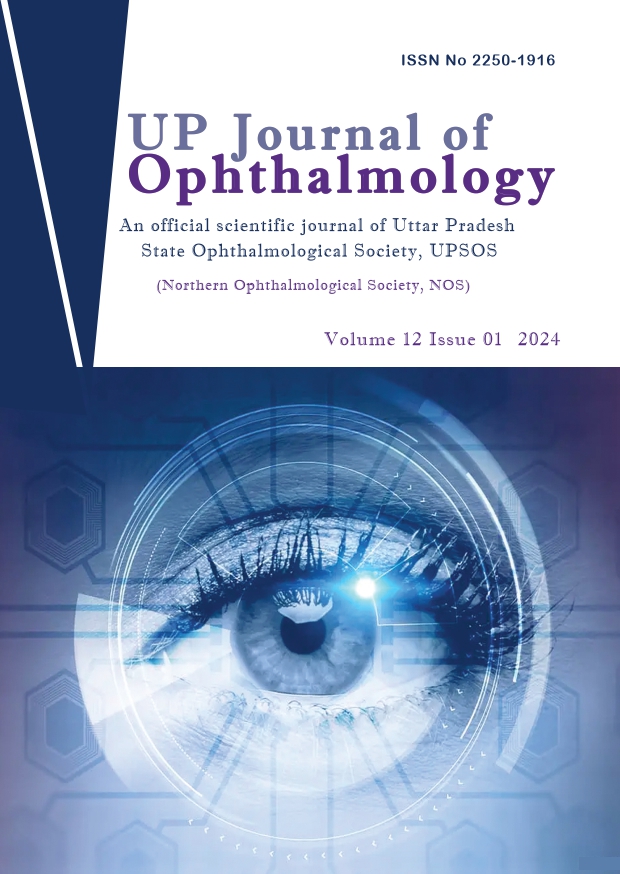Study of Developing Dry Eye After Cataract Surgery in MGD Patients
Downloads
Published
DOI:
https://doi.org/10.56692/upjo.2024120103Keywords:
Cataract surgery, Dry eye disease, Prevalence, Risk factors, Systematic review, Meibomian gland dysfunctionDimensions Badge
Issue
Section
License
Copyright (c) 2024 Suraj Singh, Rizwan A Siddiqui, Subhash C Saroj, Sadhvi Singh, Akansha Yadav

This work is licensed under a Creative Commons Attribution-NonCommercial-ShareAlike 4.0 International License.
© Author, Open Access. This article is licensed under a CC Attribution 4.0 License, which permits use, sharing, adaptation, distribution and reproduction in any medium or format, as long as you give appropriate credit to the original author(s) and the source, provide a link to the Creative Commons licence, and indicate if changes were made. The images or other third party material in this article are included in the article’s Creative Commons licence, unless indicated otherwise in a credit line to the material. If material is not included in the article’s Creative Commons licence and your intended use is not permitted by statutory regulation or exceeds the permitted use, you will need to obtain permission directly from the copyright holder. To view a copy of this licence, visit https://creativecommons.org/licenses/byncsa/4.0/.
Introduction: Many patients have complained of dry eye and symptoms of irritations after cataract surgery, and it has been shown that both the incidence and severity of dry eye use increase. In particular, the reduction in tear break-up time (TBUT) and squamous metaplasia in conjunctival impression cytology were documented after phacoemulsification.Abstract
Objectives: To investigate the dry eye symptoms after cataract surgery in MGD patients and their relationships.
Methods: This prospective observational study was conducted at the Regional Institute of Ophthalmology, Sitapur. Demographic data of 50 enrolled patients will be collected after obtaining their written informed consent. All patients underwent uncomplicated cataract surgery with age-related cataracts. In the study, patients were divided into two groups according to MGD diagnostic criteria: Group A (MGD group) and group B (control group). Shirmer 1 test (ST1), tear break up time (TBUT), and control fluoresce staining (CSF) were performed preoperatively and at 3,7, 14, and 30 days postoperatively also measured eyelid meibomian gland morphology, meibomian gland expression, and meibomian character scores before and after cataract surgery.
How to Cite
Downloads
Similar Articles
- Swati Singh, Harsh Kumar, Harish H S, Surbi Taneja, Management of Late Onset Sequential Pseudophakic Malignant Glaucoma: A Case Report and Review of Literature , UP Journal of Ophthalmology: Vol. 11 No. 03 (2023): UP JOURNAL OF OPHTHALMOLOGY
- Satyajit Sinha, Nimmi Rani, Ajit Poddar, Vishal Kishore, M Akbar, Lav Kochgaway, Himanshu Kumar, Abhishek Ranjan, Ashish Shekhar, K L Agarwal, Ajit Kumar Dwivedi Kumar, Jaishree Shekhar, Premium IOLs Selection Criteria, Investigations IOl Models and Residual Correction : An Overview , UP Journal of Ophthalmology: Vol. 8 No. 03 (2020): UP JOURNAL OF OPHTHALMOLOGY
- Aditi Saroj, Ankita Singh, Mukesh Prakash, Namrata Patel, Sneha Ranjan, Surabhi Agarwal, Shalini Mohan, Uses of Topical Cyclosporine in Ophthalmology: A Review , UP Journal of Ophthalmology: Vol. 12 No. 03 (2024): UP Journal of Ophthalmology
- Sneha Ranjan, Shalini Mohan, Modern Approach to the Treatment of Dry Eye: A Complex Multifactorial Disease , UP Journal of Ophthalmology: Vol. 12 No. 01 (2024): UP Journal of Ophthalmology
- Divya Kesarwani, Eye Banking: An Overview , UP Journal of Ophthalmology: Vol. 12 No. 02 (2024): UP Journal of Ophthalmology
- Raina Garg, Tejal Srivastava, Mohammad Saquib, Abdul Waris, Surgically Induced Focal Scleral Necrosis – A Rare Outcome , UP Journal of Ophthalmology: Vol. 13 No. 02 (2025): UP Journal of Ophthalmology
- Ajay K. Murthy, Subashini Kaliaperumal, Sandip Sarkar, Rashmi Kumari, Ocular Manifestation in Psoriasis , UP Journal of Ophthalmology: Vol. 11 No. 03 (2023): UP JOURNAL OF OPHTHALMOLOGY
- Raina Garg, Tejal Srivastava, Mohammad Saquib, Surgically Induced Focal Scleral Necrosis – A Rare Outcome , UP Journal of Ophthalmology: Vol. 13 No. 01 (2025): UP Journal of Ophthalmology
- Sameeksha Agrawal, Ankit Agrawal, Krishna K Agrawal, Vijay K. Agrawal, Dengue Fever Associated Foveolitis , UP Journal of Ophthalmology: Vol. 11 No. 01 (2023): UP JOURNAL OF OPHTHALMOLOGY
- Shalini Mohan, Shweta Sharma, Namrata Patel, Surbhi Agrawal, Role of Eye Platelet-Rich Plasma in the Treatment of Ocular Surface Disorders , UP Journal of Ophthalmology: Vol. 11 No. 03 (2023): UP JOURNAL OF OPHTHALMOLOGY
You may also start an advanced similarity search for this article.







